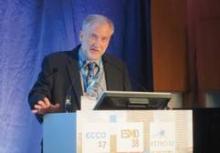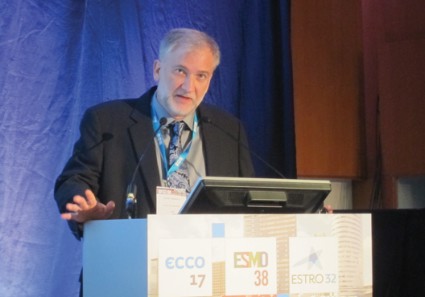User login
AMSTERDAM – Molecular profiling of cancers with an unknown primary site identified a targetable alteration in 77% of more than 1,400 cases.
Moreover, in a high proportion of cases, profiling directed clinicians to drugs not traditionally considered for cancers of unknown primary site (CUP), Dr. Zoran Gatalica said at the multidisciplinary European cancer congresses.
The study involved 1,459 CUPs, or about 3% of what is expected in the general population, and more than 50,000 patients from 30 countries. This makes it the largest group of patients to date to have their tumor biomarker profiles characterized, said Dr. Gatalica, executive medical director of Caris Life Sciences, Phoenix, Ariz.
A multiplatform approach was used that included mutational analysis by Sanger sequencing, next-generation sequencing, and polymerase chain reaction (PCR) testing; gene copy number by fluorescent or chromogenic in situ hybridization; O6-methylguanine DNA methyltransferase methylation by PCR; and protein expression analysis by immunohistochemistry.
Contrary to expectations, CUP was more prevalent in women (55%, or 822/1,459), and age offered no protection, with patients as young as 11 years and as old as 92 (average, 61 years), Dr. Gatalica said.
The most common site affected by cancer was the liver (24%), followed by other (30%) and lymph nodes (16%).
Not surprisingly, adenocarcinoma was the most common histology (45.3%), but there were also several differences in biomarkers based on histologic subtype, he said. For example, 7% of carcinomas had androgen receptor expression versus 3.3% of undifferentiated and neuroendocrine tumors.
The top "performers" were alterations in TP53 (33%), KRAS (17.5%), PIK3CA (7.4%), APC (3.6%), BRAF (3%), and epidermal growth factor receptor (EGFR) (1.1%), Dr. Gatalica said.
Dr. Gatalica also presented a few illustrative cases including a patient with liver metastases who had significant tumor reduction after being put on irinotecan (Camptostar)/5-fluorouracil on the basis of molecular profiling showing DNA topoisomerase 1 overexpression and thymidylate synthase underexpression.
A second case involved a 64-year-old woman with extensive bone disease who had a near-complete response after being directed to the EGFR-kinase inhibitor erlotinib (Tarceva) because profiling showed she carried an EGFR mutation.
Invited discussant Dr. Lajos Pusztai, codirector of the Yale Cancer Center genetics and genomics program, New Haven, Conn., described the cases as "inspiring" and said the results represent "a treasure trove of data."
Several questions remain, however, including the distribution of anomalies, how the authors defined "targetable," and whether treatment recommendations were actually followed.
"So you give a molecularly targeted treatment recommendation, but how often do physicians follow that?" he asked. "That would be a good way of gauging the test in practicality. What is the benefit rate?"
Audience members also questioned the cost of the test. An unidentified Caris spokesperson rose from the overflow crowd to say the full panel costs about €4,900 Euros (about $6,650 US), but that efforts are underway to bring the price down.
Dr. Gatalica said that in rare instances, molecular profiling "may actually improve the diagnosis of the primary site."
A recent study from the Sarah Cannon Research Institute showed that molecular profiling, using only a 92-gene reverse transcriptase PCR assay, allowed clinicians to predict the site of origin and direct site-specific therapy in 289 CUP patients, resulting in a 3-month gain in overall survival from the historic median of 9 months to 12.5 months (J. Clin. Oncol. 2013;31:217-23).
While molecular profiling represents a "conceptual leap" in the approach to CUP by emphasizing the biology of the tumor and not the primary site, "the problem is we don’t have enough good drugs," Dr. Pusztai observed.
Dr. Gatalica reported ownership and stock options in Caris Life Sciences, which sponsored the study and provided the molecular panel. Dr. Pusztai reported no relevant financial conflicts of interest.
AMSTERDAM – Molecular profiling of cancers with an unknown primary site identified a targetable alteration in 77% of more than 1,400 cases.
Moreover, in a high proportion of cases, profiling directed clinicians to drugs not traditionally considered for cancers of unknown primary site (CUP), Dr. Zoran Gatalica said at the multidisciplinary European cancer congresses.
The study involved 1,459 CUPs, or about 3% of what is expected in the general population, and more than 50,000 patients from 30 countries. This makes it the largest group of patients to date to have their tumor biomarker profiles characterized, said Dr. Gatalica, executive medical director of Caris Life Sciences, Phoenix, Ariz.
A multiplatform approach was used that included mutational analysis by Sanger sequencing, next-generation sequencing, and polymerase chain reaction (PCR) testing; gene copy number by fluorescent or chromogenic in situ hybridization; O6-methylguanine DNA methyltransferase methylation by PCR; and protein expression analysis by immunohistochemistry.
Contrary to expectations, CUP was more prevalent in women (55%, or 822/1,459), and age offered no protection, with patients as young as 11 years and as old as 92 (average, 61 years), Dr. Gatalica said.
The most common site affected by cancer was the liver (24%), followed by other (30%) and lymph nodes (16%).
Not surprisingly, adenocarcinoma was the most common histology (45.3%), but there were also several differences in biomarkers based on histologic subtype, he said. For example, 7% of carcinomas had androgen receptor expression versus 3.3% of undifferentiated and neuroendocrine tumors.
The top "performers" were alterations in TP53 (33%), KRAS (17.5%), PIK3CA (7.4%), APC (3.6%), BRAF (3%), and epidermal growth factor receptor (EGFR) (1.1%), Dr. Gatalica said.
Dr. Gatalica also presented a few illustrative cases including a patient with liver metastases who had significant tumor reduction after being put on irinotecan (Camptostar)/5-fluorouracil on the basis of molecular profiling showing DNA topoisomerase 1 overexpression and thymidylate synthase underexpression.
A second case involved a 64-year-old woman with extensive bone disease who had a near-complete response after being directed to the EGFR-kinase inhibitor erlotinib (Tarceva) because profiling showed she carried an EGFR mutation.
Invited discussant Dr. Lajos Pusztai, codirector of the Yale Cancer Center genetics and genomics program, New Haven, Conn., described the cases as "inspiring" and said the results represent "a treasure trove of data."
Several questions remain, however, including the distribution of anomalies, how the authors defined "targetable," and whether treatment recommendations were actually followed.
"So you give a molecularly targeted treatment recommendation, but how often do physicians follow that?" he asked. "That would be a good way of gauging the test in practicality. What is the benefit rate?"
Audience members also questioned the cost of the test. An unidentified Caris spokesperson rose from the overflow crowd to say the full panel costs about €4,900 Euros (about $6,650 US), but that efforts are underway to bring the price down.
Dr. Gatalica said that in rare instances, molecular profiling "may actually improve the diagnosis of the primary site."
A recent study from the Sarah Cannon Research Institute showed that molecular profiling, using only a 92-gene reverse transcriptase PCR assay, allowed clinicians to predict the site of origin and direct site-specific therapy in 289 CUP patients, resulting in a 3-month gain in overall survival from the historic median of 9 months to 12.5 months (J. Clin. Oncol. 2013;31:217-23).
While molecular profiling represents a "conceptual leap" in the approach to CUP by emphasizing the biology of the tumor and not the primary site, "the problem is we don’t have enough good drugs," Dr. Pusztai observed.
Dr. Gatalica reported ownership and stock options in Caris Life Sciences, which sponsored the study and provided the molecular panel. Dr. Pusztai reported no relevant financial conflicts of interest.
AMSTERDAM – Molecular profiling of cancers with an unknown primary site identified a targetable alteration in 77% of more than 1,400 cases.
Moreover, in a high proportion of cases, profiling directed clinicians to drugs not traditionally considered for cancers of unknown primary site (CUP), Dr. Zoran Gatalica said at the multidisciplinary European cancer congresses.
The study involved 1,459 CUPs, or about 3% of what is expected in the general population, and more than 50,000 patients from 30 countries. This makes it the largest group of patients to date to have their tumor biomarker profiles characterized, said Dr. Gatalica, executive medical director of Caris Life Sciences, Phoenix, Ariz.
A multiplatform approach was used that included mutational analysis by Sanger sequencing, next-generation sequencing, and polymerase chain reaction (PCR) testing; gene copy number by fluorescent or chromogenic in situ hybridization; O6-methylguanine DNA methyltransferase methylation by PCR; and protein expression analysis by immunohistochemistry.
Contrary to expectations, CUP was more prevalent in women (55%, or 822/1,459), and age offered no protection, with patients as young as 11 years and as old as 92 (average, 61 years), Dr. Gatalica said.
The most common site affected by cancer was the liver (24%), followed by other (30%) and lymph nodes (16%).
Not surprisingly, adenocarcinoma was the most common histology (45.3%), but there were also several differences in biomarkers based on histologic subtype, he said. For example, 7% of carcinomas had androgen receptor expression versus 3.3% of undifferentiated and neuroendocrine tumors.
The top "performers" were alterations in TP53 (33%), KRAS (17.5%), PIK3CA (7.4%), APC (3.6%), BRAF (3%), and epidermal growth factor receptor (EGFR) (1.1%), Dr. Gatalica said.
Dr. Gatalica also presented a few illustrative cases including a patient with liver metastases who had significant tumor reduction after being put on irinotecan (Camptostar)/5-fluorouracil on the basis of molecular profiling showing DNA topoisomerase 1 overexpression and thymidylate synthase underexpression.
A second case involved a 64-year-old woman with extensive bone disease who had a near-complete response after being directed to the EGFR-kinase inhibitor erlotinib (Tarceva) because profiling showed she carried an EGFR mutation.
Invited discussant Dr. Lajos Pusztai, codirector of the Yale Cancer Center genetics and genomics program, New Haven, Conn., described the cases as "inspiring" and said the results represent "a treasure trove of data."
Several questions remain, however, including the distribution of anomalies, how the authors defined "targetable," and whether treatment recommendations were actually followed.
"So you give a molecularly targeted treatment recommendation, but how often do physicians follow that?" he asked. "That would be a good way of gauging the test in practicality. What is the benefit rate?"
Audience members also questioned the cost of the test. An unidentified Caris spokesperson rose from the overflow crowd to say the full panel costs about €4,900 Euros (about $6,650 US), but that efforts are underway to bring the price down.
Dr. Gatalica said that in rare instances, molecular profiling "may actually improve the diagnosis of the primary site."
A recent study from the Sarah Cannon Research Institute showed that molecular profiling, using only a 92-gene reverse transcriptase PCR assay, allowed clinicians to predict the site of origin and direct site-specific therapy in 289 CUP patients, resulting in a 3-month gain in overall survival from the historic median of 9 months to 12.5 months (J. Clin. Oncol. 2013;31:217-23).
While molecular profiling represents a "conceptual leap" in the approach to CUP by emphasizing the biology of the tumor and not the primary site, "the problem is we don’t have enough good drugs," Dr. Pusztai observed.
Dr. Gatalica reported ownership and stock options in Caris Life Sciences, which sponsored the study and provided the molecular panel. Dr. Pusztai reported no relevant financial conflicts of interest.
AT THE EUROPEAN CANCER CONGRESS 2013
Major finding: Targetable alterations were identified in 77% of cases.
Data source: A retrospective molecular analysis of 1,459 patients with cancers of unknown primary site.
Disclosures: Dr. Gatalica reported ownership and stock options in Caris Life Sciences, which sponsored the study and provided the molecular panel. Dr. Pusztai reported no relevant financial conflicts of interest.

